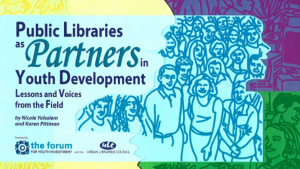
Grocery stores. Why aren’t neighborhood youth centers like grocery stores? So much an accepted necessity for family functioning that no one would voluntarily choose to live in a neighborhood that did not have access to at least one and preferably several — convenience, full service, specialty. When moving into a neighborhood, families look for functions — grocery stores, banks, retail shopping strips, religious institutions, transportation links, parks and recreational facilities.They check the quality of childcare centers or schools if they have or are planning on having children and ask about crime and neighborhood life. But do they ask about youth services? Is there the generic youth services equivalent of the grocery store or even the park that is on most families’ checklists? Probably not. Settlement houses, recreation centers, youth sports leagues and, most recently, community schools (e.g., Beacons, Lighthouses, etc.) are the closest this country has come to developing generic icons for youth services. But we have a long way to go. And my concern is that we have not yet realized just how urgent it is that we start.
What is our simple vision of what should be in every community? Is it centers — places that can become the hub for a full range of activities from sports to family planning and GED programs to community service placements? What about specialized programs such as sports leagues or orchestras? And what about youth-only or youth-friendly services — health, counseling, job training — and social outlets? Let’s think like urban planners. What, or who, should be within a half-mile radius, a one-mile radius, a five-mile radius?
We need to learn a lesson from the profit-making world — the best way to guarantee revenue is to generate demand. For decades we have produced statistics demonstrating that what we offer is needed. What we have not demonstrated is that what we offer is valued — by youth, parents or communities. The issue of equity (ensuring access to all who need it) has superseded the issue of value (demonstrating demand by those who can afford it). As the first argument fades we need to solidify the second.
Words like marketing and demand raise hackles. But a solid infrastructure of services that reaches all youth will require public and private commitments and contributions generated from frank discussions not just about what youth, families and communities need, but what they are willing to pay for. And they are, at all income levels, willing to pay for some things.
The industries that keep youth clothed and entertained are booming. This is where young people of all income levels spend their discretionary dollars. The market for camps, challenges and career exploration is also growing — parents, primarily of middle and upper income, are spending money to make sure that their youth are kept busy, engaged and exploring. These two markets are real — they have clearly defined products and engaged in heavy market segmentation and advertising. They charge for their services, and people pay. The market for traditional compensatory youth services is drying up however. Its primary consumers (those who actually purchase the services) are not parents and youth, but public and private funders investing in prevention and intervention. It is market driven by outcome, not demand, and one whose value is defined more by data on what happens to youth and communities that don’t have services and opportunities.
Addressing the equity question will mean, ultimately, that there are subsidies for the field (just as there are for child care and health care) or business incentives (just as those community development corporations work out to bring grocery stores back into inner cities). But the challenge at hand is market development, pure and simple. If we do not demonstrate that families and communities with income demand and pay for these services, we will continue to lose ground with the argument that those without income need them. There is a market. But we haven’t named it, segmented it and tallied up the dollars spent. We need to define generically what youth need and what those whose families and communities can pay are offered, use and like. Then we need to take a deep breath and begin finding ways to let the market work.
We welcome your contributions to the topic. Please reach out to talkwithus@kpcatalysts.com if you’d like to join to the discussion.
Article was originally published in

Pittman, K. (1995, September/October). “Where’s The Market?.” Washington, DC: The Forum for Youth Investment. A version of this article appears in Youth Today. September 1, 1995



No comment yet, add your voice below!